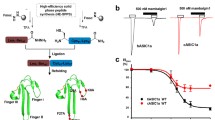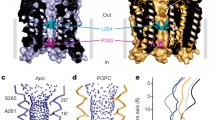Abstract
Predatory sea snails from the Conus family produce a variety of venomous small helical peptides called conantokins that are rich in γ-carboxyglutamic acid (Gla) residues. As potent and selective antagonists of the N-methyl-d-aspartate receptor, these peptides are potential therapeutic agents for a variety of neurological conditions. The two most studied members of this family of peptides are con-G and con-T. Con-G has Gla residues at sequence positions 3, 4, 7, 10, and 14, and requires divalent cation binding to adopt a helical conformation. Although both Ca2+ and Mg2+ can fulfill this role, Ca2+ induces dimerization of con-G, whereas the Mg2+-complexed peptide remains monomeric. A variant of con-T, con-T[K7γ] (γ is Gla), contains Gla residues at the same five positions as in con-G and behaves very similarly with respect to metal ion binding and dimerization; each peptide binds two Ca2+ ions and two Mg2+ ions per helix. To understand the difference in metal ion selectivity, affinity, and the dependence on Ca2+ for dimer formation, we report here the structure of the monomeric Cd2+/Mg2+–con-T[K7γ] complex, and, by comparison with the previously published con-T[K7γ]/Ca2+ dimer structure, we suggest explanations for both metal ion binding site specificity and metal-ion-dependent dimerization.





Similar content being viewed by others
Abbreviations
- Con-G:
-
Conantokin-G
- Con-T:
-
Conantokin-T
- Gla:
-
γ-Carboxyglutamate
- NMDAR:
-
N-Methyl-d-aspartate receptor
References
McIntosh J, Olivera BM, Cruz L, Gray W (1984) J Biol Chem 259:14343–14346
Haack JA, Rivier J, Parks TN, Mena EE, Cruz LJ, Olivera BM (1990) J Biol Chem 265:6025–6029
Prorok M, Warder SE, Blandl T, Castellino FJ (1996) Biochemistry 35:16528–16534
Skjaerbaek N, Nielsen KJ, Lewis RJ, Alewood P, Craik DJ (1997) J Biol Chem 272:2291–2299
Dai Q, Prorok M, Castellino FJ (2004) J Mol Biol 336:731–744
Dai Q, Castellino FJ, Prorok M (2004) Biochemistry 43:13225–13232
Cnudde SE, Prorok M, Dai Q, Castellino FJ, Geiger JH (2007) J Am Chem Soc 129:1586–1593
Prorok M, Castellino FJ (1998) J Biol Chem 273:19573–19578
Dai QY, Sheng ZY, Geiger JH, Castellino FJ, Prorok M (2007) J Biol Chem 282:12641–12649
Cerasoli E, Sharpe BK, Woolfson DN (2005) J Am Chem Soc 127:15008–15009. doi:10.1021/ja0543604
Gribbon C, Channon KJ, Zhang WJ, Banwell EF, Bromley EHC, Chaudhuri JB, Oreffo ROC, Woolfson DN (2008) Biochemistry 47:10365–10371. doi:10.1021/bi801072s
Shekhawat SS, Porter JR, Sriprasad A, Ghosh I (2009) J Am Chem Soc 131:15284–15290. doi:10.1021/ja9050857
Zimenkov Y, Dublin SN, Ni R, Tu RS, Breedveld V, Apkarian RP, Conticello VP (2006) J Am Chem Soc 128:6770–6771. doi:10.1021/ja0605974
Otwinowski ZaM W (1997) Methods Enzymol 276:307–326
McCoy AJ, Grosse-Kunstleve RW, Storoni LC, Read RJ (2005) Acta Crystallogr D 61:458–464
Collaborative Computational Project N (1994) Acta Crystallogr D 50:760–763
Matthews BW (1968) J Mol Biol 33:491–497
Sheldrick GM, Schneider TR (1997) In: Sweet RM, Carter CW Jr (eds) Methods in enzymology. Academic Press, Orlando, pp 319–343
Gowd KH, Twede V, Watkins M, Krishnan KS, Teichert RW, Bulaj G, Olivera BM (2008) Toxicon 52:203–213. doi:10.1016/j.toxicon.2008.04.178
Teichert RW, Jimenez EC, Twede V, Watkins M, Hollmann M, Bulaj G, Olivera BM (2007) J Biol Chem 282:36905–36913
Twede VD, Teichert RW, Walker CS, Gruszczynski P, Kazmierkiewicz R, Bulaj G, Olivera BM (2009) Biochemistry 48:4063–4073. doi:10.1021/bi802259a
Prorok M, Castellino FJ (2001) Curr Drug Targ 2:313–322
Acknowledgments
We thank the following for financial support: GR-179 (085P100549) from the Michigan Economic Development Corporation (to J.H.G.), NIH Grant HL019982 (to F.J.C.), and NIH Grant GM0638947 (to J.H.G.). CCDC-667723 contains the supplementary crystallographic data for this paper. These data can be obtained free of charge from the Cambridge Crystallographic Data Centre via http://www.ccdc.cam.ac.uk/data_request/cif.
Author information
Authors and Affiliations
Corresponding author
Rights and permissions
About this article
Cite this article
Cnudde, S.E., Prorok, M., Castellino, F.J. et al. Metal ion determinants of conantokin dimerization as revealed in the X-ray crystallographic structure of the Cd2+/Mg2+–con-T[K7γ] complex. J Biol Inorg Chem 15, 667–675 (2010). https://doi.org/10.1007/s00775-010-0633-2
Received:
Accepted:
Published:
Issue Date:
DOI: https://doi.org/10.1007/s00775-010-0633-2




